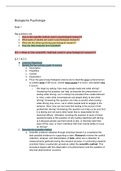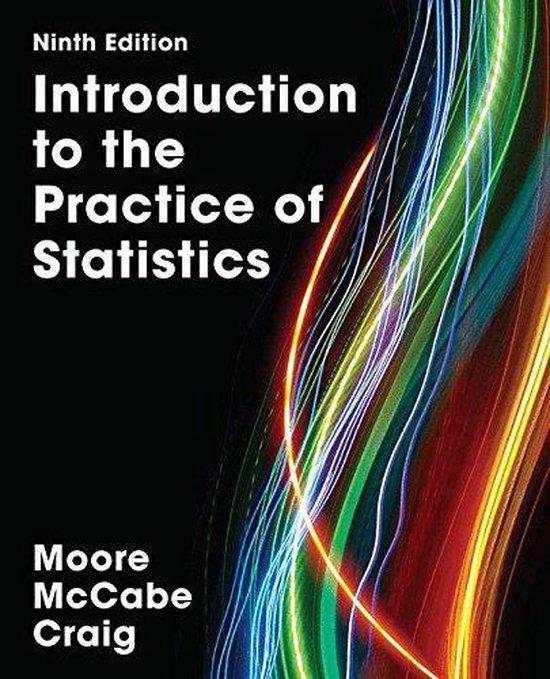Biologische Psychologie
Deel 1
Big questions are:
1. How is the scientific method used in psychological research?
2. What types of studies are used in psychological research?
3. What are the ethics governing psychological research?
4. How are data analyzed and evaluated?
Q1 → How is the scientific method used in psychological research?
§ 2.1 & 2.2
❖ Learning Objectives:
1. Identify the four primary goals of science
a. Description
b. Prediction
c. Control
d. Explanation
e. Thus: the goal of psychological science are to describe what a phenomenon
is, predict when it will occur, control what causes it to occur, and explain why
it occurs
i. We begin by asking: How many people really text while driving?
Answering this question can help us describe the phenomenon of
texting while driving—as in noting how prevalent this unsafe behavior
is. Now, under what circumstances are people likely to text while
driving? Answering this question can help us predict when texting
while driving may occur—as in which people tend to engage in the
behavior. Next, how can we know that texting is the source of the
problematic driving? Answering this question can help us be sure that
it is texting and not some other factor that is responsible for the
observed effects. Ultimately, knowing the answers to each of these
questions leads to the question of why texting interferes with driving.
Is it because people use their hands to text, or that they take their
eyes off the road, or that it interferes with their mental ability to focus
on driving?
2. Describe the scientific method
a. Scientific evidence obtained through empirical research is considered the
best possible evidence for supporting a claim. Research involves the careful
collection, analysis, and interpretation of data, which are a collection of
measurements gathered during the research process. In conducting research,
scientists follow a systematic procedure called the scientific method. This
procedure begins with the observation of a phenomenon and the question of
why that phenomenon occurred.
,3. Differentiate between theories, hypotheses and research
a.
❖
Good research reflects the cyclical process shown in the figure above
,§ 2.3
❖ Replication in research is important because it involves repeating a study to see if the
results are the same (or similar). Mind that critically thinking in conducting replication
studies is required since contextual factors, such as the research setting or time
period, are likely to affect research findings.
§ 2.4
❖ To be a critical thinker is essential for becoming an educated consumer of
information
➢ The first step in critical thinking is to question information
➢ The evaluation of information is the second step in critical thinking. To answer
our questions, we need to go to the source of the claim.
■ For example, imagine you hear the claim that using a cell phone while
driving is more dangerous than driving while intoxicated. Upon hearing
this claim, a critical thinker immediately asks for definitions. For
example, what do they mean by “using a cell phone”? Do they mean
talking or texting?
➢ Next, you need to think about the evidence offered by the source to support
the claim (well-supported evidence). Does the evidence at the source of the
claim take the form of scientific evidence?
❖ Thus, critical thinkers must always stay vigilant - always be on the lookout for
unreasonable claims and conclusions that may not be valid interpretations of the
date. Hone your critical thinking skills by practicing them as often as possible
,Q2 → What types of studies are used in psychological research?
§ 2.5, 2.6, 2.7, 2.8 & 2.9
❖ Learning Objectives
1. Distinguish between descriptive studies, correlational studies, and experiments
a. Descriptive research
i. Consists of:
1. Case Studies,
a. Is the intensive examination (observation, recording,
and description) of an unusual person or organization
2. Observational Studies,
a. Two main types:
i. Participant observation: the researcher is
involved in the situation
ii. Naturalistic observation: the observer is
passive, separated from the situation and
making no attempt to change or alter ongoing
behavior
b. These observational techniques involve the systematic
assessment and coding of overt behavior
3. and Self-reports and interviews
a. Self-reports can be used to gather data from a large
number of people in a short time
b. Interviews can be used with groups that cannot be
studies through surveys, such as younger children.
Interviews are also helpful in gaining a more in-depth
view of a respondent’s opinions, experiences, and
attitudes.
ii. Involves observing behavior to describe that behavior objectively and
systematically
iii. Needs to guard against bias
1. Reactivity: the presence of the observer might alter the
, behavior being observed
2. Observer bias: consists of systematic errors in observation that
occur because of an observer’s expectations
3. Experimenter expectancy effect is when there is evidence that
observer expectations can even change the behavior being
observed
4. How do researchers protect against experimenter expectancy
effects? It is best if the person running the study is blind to, or
unaware of, the study’s hypotheses
b. Correlational studies
i. Examine how variables are naturally related in the real word, without
any attempt by the researcher to alter them or assign causation
between them
ii. Describe and predict how variables are related
1. The first step is to create a scatter plot
a. Provides a convenient picture of data
2. Positive correlation: when higher or lower values on one
variable predict higher or lower values on a second variable
(smoking and cancer)
3. Negative correlation: when a decrease in one variable predicts
an increase in the other variable (exercise and weight)
4. Zero correlation: when one variable is not predictably related to
a second variable (height and intelligence)
iii. Cannot be used to determine the causal relationship between the
variables
iv. Just because two things are related, even strongly related, does not
mean that one is causing the other
v. Are used because of ethical reasons: some researches are unethical
to perform, thus correlational studies are required
vi. By providing important information about the natural relationships
between variables, researchers are able to make valuable predictions.
1. For example, correlational research has identified a strong
relationship between depression and suicide. For this reason,
clinical psychologists often assess symptoms of depression to
determine suicide risk. Typically, researchers who use the
correlational method use other statistical procedures to rule out
potential third variables and problems with the direction of the
effect. Once they have shown that a relationship between two
variables holds even when potential third variables are taken
into account, researchers can be more confident that the
relationship is meaningful
c. Experimental method
i. Controls and explains
1. In experimental research, the researcher has maximal control
over the situation. The researcher manipulates one variable to
to measure the effect on a second variable






